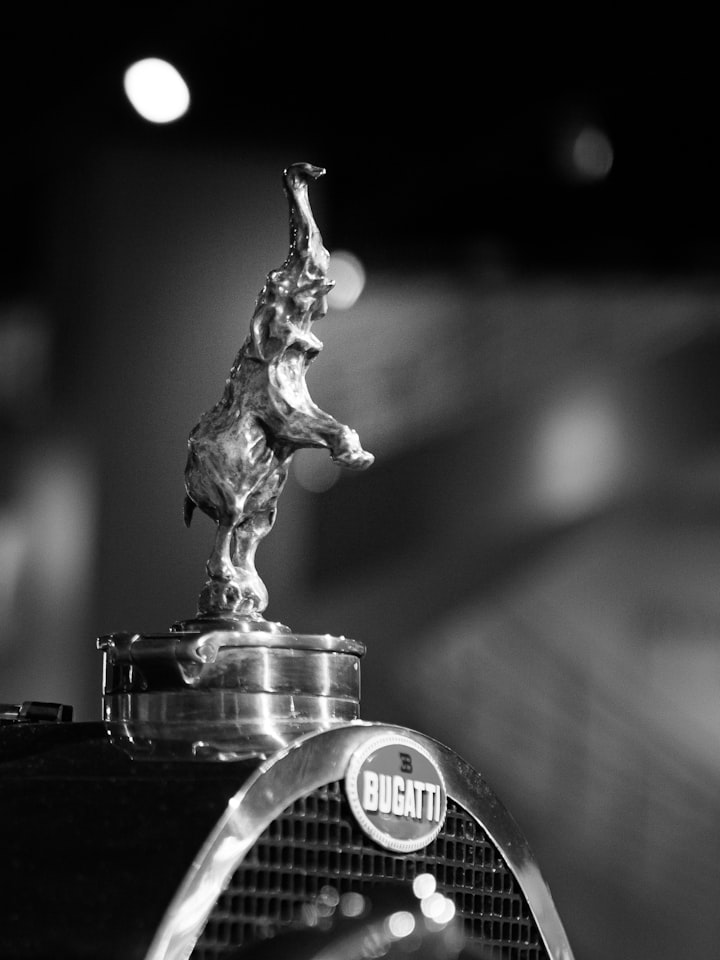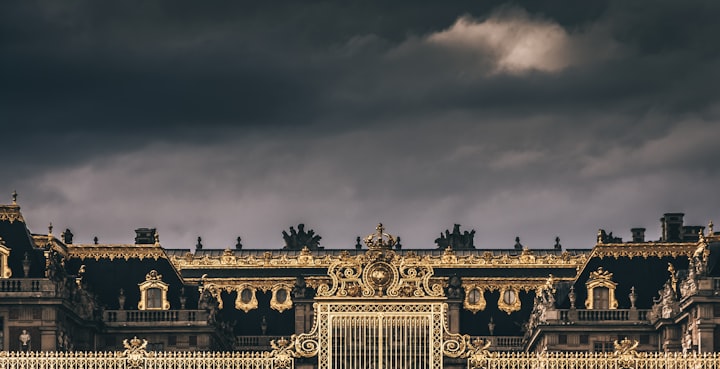The "Other" Bugatti
How One Man Turned the Automobile into an Art Form

Most of us are familiar with the Bugatti Brand-- and the legacy of the unparalleled French luxury automobile manufacturer based in Molsheim that has delivered models from the Veyron to the Chiron to La Voiture Noire. After all, Bugatti is famously responsible for designs almost overwhelming in their aesthetic lushness. These are cars that exalt in striking colors and elegant lines-- the price attached is par for the course when one considers an engine that's subtle purr conceals its true power.
And perhaps a smaller branch of us are also familiar with the family behind the machine. Here, it might be more accurate to refer to the Bugatti’s as an Italian artistic dynasty. Giovanni Bugatti was a designer and architect, and his son, Carlo (born in 1856) would achieve renown as an Art Nouveau designer, furniture-builder, jeweller, and silversmith. Carlo’s elder son, Ettore (born 1881), would eventually become the engineer responsible for some of the most impressive Art Deco automobile designs to grace the international stage.
But this article is not concerned with Ettore, or Carlo, or even Giovanni. Rather, it is interested in the so-called “other” Bugatti, Ettore’s younger brother, Rembrandt. While Ettore channeled his brilliance and vision into mechanical design, the rather auspiciously-named younger brother, Rembrandt, was all artist. His forefathers and older brother were concerned with design in relation to functionality-- but Rembrandt was interested in art for art’s sake.
It might be too much of a stretch to call Rembrandt’s life a kind of allegory-- after all, he died at the premature age of 31 by his own hand while his father and brother significantly outlived him. Something here might be said about the longevity of functionality and ephemerality of true art. At the time of his death, he was already a prolific and renowned sculptor, but this did not seem to assuage whatever dark passion presumably possessed him.
Like his older brother Ettore, Rembrandt was born in Milan, Italy, although he arrived in 1884. As a child and adolescent, Rembrandt was eager to aid his father in his work, and was a staple at his studio. When the youth was only fifteen, Rembrandt’s first sculpture was discovered in this very studio, hidden beneath a delicate layer of wrapping paper. It was then that his artistic talent was understood by his family for the first time.
While Ettore became an apprentice at a bicycle manufacturing company after his schooling, experimenting with the application of engines to tricycles-- his brother Rembrandt chose a different path. Although he began as a student at the Brera Academy in Milan and had his first showings there, after moving to Paris with the rest of his family, he began to mingle with the French art scene. In 1904, at the age of nineteen, Rembrandt enjoyed the first of what would become annual exhibitions at the Galerie Hebrard.
His work dealt primarily with animals, an unexpected and superficially senseless fixation that would continue until his untimely death. While others at this time focused on the absurdly abstract, or the familiar and human, Rembrandt was interested in that which existed beyond human conceptualizations of embodied experience and consciousness. He made frequent visits to zoos in Antwerp, as well as the Jardin des Plantes in Paris. He was known to gaze intently at the animal subjects that served as his models while he worked, which perhaps contributed to his ability to capture their dynamism and individuality.
During a period in the history of Europe where the animal was considered something base and crude, hardly worthy of recognition, Rembrandt found something to appreciate. To be fair, attitudes towards animals were shifting, as is evidenced by the burgeoning popularity of zoos. Darwin’s On the Origin of Species was published some decades before in 1859, a work that would create new interest in human connections to common animal ancestors. It was out of this context that Rembrandt emerged, sculpting pieces that captured the ephemeral gestures and characters of the animals he surveyed. Although he began with domestic animals, namely dogs and cows, because those were the animals he was most familiar with in his day to day life, he gradually began to experiment with more exotic creatures.
In his sculpture, Mon Chien (My Dog), a rendering of Bugatti’s dachshund, Wurst, the artist’s own fingerprints, left sweetly in the wet clay of the original mold, lend the dog an intimacy and familiarity, which is only complemented by the warm light of the bronze hues. More unexpected pieces, like Giant Anteater, are equally if not more compelling, albeit for a different reason. The almost supernatural curves of the neck and abstract texture of the fur, endow the creature with an almost Art Deco sensibility. The animal is rendered into an extension of an era of design, but never abandons its inherent natural qualities or personality. Rembrandt is particularly well known for his sculptures of wild felines-- from the heady sinews and musculature evidenced in Seated Jaguar, to the soft, alert stance of Twisting Panther, Bugatti again and again revealed not only his exceptionally deft and skilled hands, but also his uncanny vision and empathy.
The casual stance of Twisting Gnu--Scratching its Leg, elevates the rather banal gesture of animal grooming to an action of some consequence, for it is evidence of the artistry of nature itself. In sculpting what nature had already taken upon itself to sculpt (through millions of years of evolution), Rembrandt was consciously or unconsciously raising questions about the figure of the artist in relation to divinity and being.
To be sure, he would, on occasion, foray into sculpting people. These pieces, such as Le Reveil or Standing Boy, are luminous even now in bronze, less textured and more softly curved than some of his other works. Gleaming and vaguer than the striking physicality of his animals, these nudes lack the compelling gravity of his animal bronzes, which seem alive with a kind of naturalness most artists only ever dream of capturing. This interest in depicting both male and female nudes, which reached a fever pitch in the years 1906 and 1907, might be interpreted as Rembrandt’s attempt to understand the mysteries of the human, materially-- or to render his own complex relational and social experiences with people in a medium he was already well-versed in: clay. And perhaps this is where Rembrandt’s story begins to become something akin to tragedy.
Although he came from an artistic family, Rembrandt’s particular brand of sculpture was less functional than the creations of his fellows. Little is known about Rembrandt’s romantic predilections, besides the fact that they were troubled. Some rumors go so far as to describe him as having an affair with his brother’s wife, Barbara.
When the first world war broke out, Rembrandt became a volunteer paramedic, serving as a stretcher bearer. Even before the outright explosion of conflict, Bugatti’s finances had been in some level of disrepair, and his health unpredictable. Perhaps most devastating though, was the fact that the animals of the Antwerp Zoo-- those creatures Rembrandt knew intimately from sculpting them with his very own hands, learning the secret textures of their hearts and beings-- were slaughtered when the city descended into wartime. Such creatures were a luxury that could not be afforded when so much human life was likewise being extinguished.
The destruction and seemingly senseless carnage evoked by first WWI, and later WWII would indelibly impact the cultural and artistic landscape for decades to come. The decades following the Great War were characterized by the rise of modernism-- a movement which embraced the complexities and abstractions of human interiority, loss, exile, and despair. It was also characterized by the advent of new technology and urbanization. Art, literature, and music were all impacted by the War, which effectively permeated all levels of society. To some extent, much of our contemporary art and culture is a direct result of the advances and turmoil experienced during this period. The damage done to veterans too, especially those specifically attuned to the lives and emotions of others, human or animal, cannot be overstated.
In the end, a combination of impossible factors, from the increasing difficulty of his financial situation, to the crippling PTSD and depression resulting from his experiences in the war, made life unlivable for the young artist. In 1916, at the age of 31, Rembrandt Bugatti gassed himself inside his Paris apartment.
This was a loss that is difficult to put into words, not only for his immediate family, but also for the art community as a whole. Throughout his career, Rembrandt’s life and works had influenced other painters and sculptors of some renown, including Auguste Rodin. The revolutionary nature of his pieces is comparable to those of Cezanne, and the shortness of his career is comparable to those of Modigliani, and Franz Marc. Even though his pieces, of which there are many (because he was an incredibly vibrant and prolific creator), have long been coveted by art-collectors and private dealers, only now is his legacy beginning to cement itself. During his life, Bugatti was well known, but in death, he sank into a strange kind of absurdity, by virtue of being just another member of an incredibly brilliant family.
One needs to only glance at the striking intimacy of Mes Antelopes, to recognize his genius, although as is true with all great art, articulating what makes the piece so special is more difficult. Despite the man’s incredibly brief stay in the art world, he managed to also fundamentally transform the Bugatti automobile brand. For example, it is a miniature replica of his Dancing Elephant sculpture which is perched in a place of honor on the radiator cap of the Bugatti Type 41 Royale. The daintiness of the creature, juxtaposed with the beauty of the molding and the power of its being and naturalness would go on to become the symbol of the Bugatti Brand.
Today, the Bugatti website proudly proclaims, “Just as Ettore had a flair for creating automotive artworks, Rembrandt Bugatti was renowned for his extraordinary artistic talent and outstanding skill at crafting surfaces. Rembrandt Bugatti represents the strong artistic roots of the Bugatti family. That was why Bugatti dedicated its fourth Legends model to him. The model was unveiled at the Geneva Motor Show in 2014.”
If we only take one thing away from the winding and brief history of Rembrandt Bugatti, let it be this: In his unflinching devotion to secret lives of animals, which he rendered so lovingly in bronze, he lived up to his name and helped make the automobile into a kind of artform.
About the Creator
Katie Alafdal
queer poet and visual artist. @leromanovs on insta






Comments
There are no comments for this story
Be the first to respond and start the conversation.